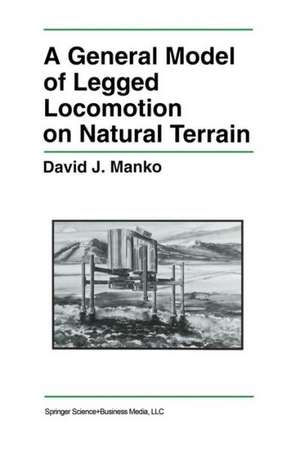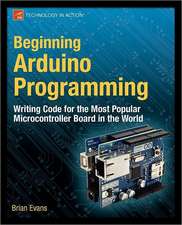A General Model of Legged Locomotion on Natural Terrain: The Springer International Series in Engineering and Computer Science, cartea 179
Autor David J. Mankoen Limba Engleză Paperback – 10 noi 2012
A General Model of Legged Locomotion on Natural Terrain develops a dynamic mechanism model that characterizes indeterminate interactions of a closed-chain robot with its environment. The approach is applicable to any closed-chain mechanism with sufficient contact compliance, although legged locomotion on natural terrain is chosen to illustrate the methodology. The modeling and solution procedures are general to all walking machine configurations, including bipeds, quadrupeds, beam-walkers and hopping machines.
This work develops a functional model of legged locomotion that incorporates, for the first time, non-conservative foot-soil interactions in a nonlinear dynamic formulation. The model was applied to a prototype walking machine, and simulations generated significant insights into walking machine performance on natural terrain. The simulations are original and essential contributions to the design, evaluation and control of these complex robot systems. While posed in the context of walking machines, the approach has wider applicability to rolling locomotors, cooperating manipulators, multi-fingered hands, and prehensile agents.
| Toate formatele și edițiile | Preț | Express |
|---|---|---|
| Paperback (1) | 364.56 lei 6-8 săpt. | |
| Springer Us – 10 noi 2012 | 364.56 lei 6-8 săpt. | |
| Hardback (1) | 554.19 lei 6-8 săpt. | |
| – | 554.19 lei 6-8 săpt. |
Din seria The Springer International Series in Engineering and Computer Science
- 20%
 Preț: 594.49 lei
Preț: 594.49 lei - 24%
 Preț: 859.55 lei
Preț: 859.55 lei - 20%
 Preț: 1847.13 lei
Preț: 1847.13 lei - 20%
 Preț: 1228.27 lei
Preț: 1228.27 lei - 24%
 Preț: 866.26 lei
Preț: 866.26 lei - 18%
 Preț: 609.91 lei
Preț: 609.91 lei - 20%
 Preț: 618.64 lei
Preț: 618.64 lei - 18%
 Preț: 744.67 lei
Preț: 744.67 lei - 20%
 Preț: 569.56 lei
Preț: 569.56 lei - 18%
 Preț: 1177.92 lei
Preț: 1177.92 lei - 18%
 Preț: 921.36 lei
Preț: 921.36 lei - 20%
 Preț: 621.14 lei
Preț: 621.14 lei - 18%
 Preț: 911.94 lei
Preț: 911.94 lei - 20%
 Preț: 621.64 lei
Preț: 621.64 lei - 15%
 Preț: 612.85 lei
Preț: 612.85 lei - 20%
 Preț: 618.96 lei
Preț: 618.96 lei - 18%
 Preț: 912.40 lei
Preț: 912.40 lei - 20%
 Preț: 619.58 lei
Preț: 619.58 lei - 20%
 Preț: 950.07 lei
Preț: 950.07 lei - 20%
 Preț: 621.01 lei
Preț: 621.01 lei - 18%
 Preț: 910.11 lei
Preț: 910.11 lei - 20%
 Preț: 950.72 lei
Preț: 950.72 lei - 18%
 Preț: 919.85 lei
Preț: 919.85 lei - 20%
 Preț: 620.07 lei
Preț: 620.07 lei - 15%
 Preț: 617.89 lei
Preț: 617.89 lei - 18%
 Preț: 913.32 lei
Preț: 913.32 lei - 18%
 Preț: 1173.85 lei
Preț: 1173.85 lei - 18%
 Preț: 920.45 lei
Preț: 920.45 lei - 15%
 Preț: 619.12 lei
Preț: 619.12 lei - 18%
 Preț: 911.64 lei
Preț: 911.64 lei - 18%
 Preț: 910.58 lei
Preț: 910.58 lei - 20%
 Preț: 1234.64 lei
Preț: 1234.64 lei - 20%
 Preț: 1728.85 lei
Preț: 1728.85 lei
Preț: 364.56 lei
Nou
Puncte Express: 547
Preț estimativ în valută:
64.51€ • 75.65$ • 56.65£
64.51€ • 75.65$ • 56.65£
Carte tipărită la comandă
Livrare economică 04-18 februarie 26
Preluare comenzi: 021 569.72.76
Specificații
ISBN-13: 9781461365884
ISBN-10: 1461365880
Pagini: 132
Ilustrații: XII, 116 p.
Dimensiuni: 155 x 235 x 7 mm
Greutate: 0.2 kg
Ediția:Softcover reprint of the original 1st ed. 1992
Editura: Springer Us
Colecția Springer
Seria The Springer International Series in Engineering and Computer Science
Locul publicării:New York, NY, United States
ISBN-10: 1461365880
Pagini: 132
Ilustrații: XII, 116 p.
Dimensiuni: 155 x 235 x 7 mm
Greutate: 0.2 kg
Ediția:Softcover reprint of the original 1st ed. 1992
Editura: Springer Us
Colecția Springer
Seria The Springer International Series in Engineering and Computer Science
Locul publicării:New York, NY, United States
Public țintă
ResearchCuprins
1 Introduction.- 2 Background.- 3 Legged Locomotion Model.- 4 Solution Procedures.- 5 Application to a Prototype Walking Machine.- 6 Verification Studies.- 7 Model Applications.- 8 Summary.- A Vertical Foot-Soil Experiments.- B Perturbation Parameters.- C Inertial Properties for the AMBLER Massless Leg Model.- C.1 Reallocation of Inner Link Properties.- C.2 Reallocation of Outer Link Properties.- C.3 Reallocation of Vertical Link Properties.










